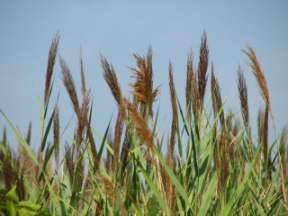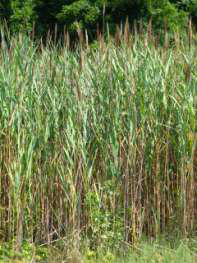 Phragmites
Phragmites
(Phragmites australis (Cav.) Trin. ex Steud.)
|
Classification |
| Kingdom: |
Plantae |
| Division: |
Magnoliophyta |
| Class: |
Liliopsida |
| Order: |
Poales |
| Family: |
Poaceae |
| Genus: |
Phragmites |
| Species: |
australis |
 Characteristics: Phragmites, sometimes known as Giant Reed, is a tall thick stemmed grass. The leaves are flat, sharply pointed and green to bluish in color. Leaves can be up to 20 inches long and 2 inches wide; they are rough edged, sheathing the stem at the base. It bears spikelets with many silky hairs in large terminal clusters that are initially reddish colored but change to silver. Phragmites is invasive and has replaced extensive regions of tidal marshes. It rarely produces seeds, rather spreads horizontally through rhizomes over the surface of the ground. It can form dense stands that exclude all other species.
Characteristics: Phragmites, sometimes known as Giant Reed, is a tall thick stemmed grass. The leaves are flat, sharply pointed and green to bluish in color. Leaves can be up to 20 inches long and 2 inches wide; they are rough edged, sheathing the stem at the base. It bears spikelets with many silky hairs in large terminal clusters that are initially reddish colored but change to silver. Phragmites is invasive and has replaced extensive regions of tidal marshes. It rarely produces seeds, rather spreads horizontally through rhizomes over the surface of the ground. It can form dense stands that exclude all other species.
Habitat: It can grow in freshwater and brackish marshes, as well as ditches and waste places.
Range: Phragmites can be found throughout North America, except the far north.
Native American Uses: Phragmites was used for arrows, blow guns, and flutes. The stems of this species were used as thatching material for roofs. The tiny reddish seeds were ground into flour or made into gruel. The rootstocks could be crushed and washed to obtain flour. In addition, the Iroquois Indians used phragmites as a ceremonial medicine.
Uses: Phragmites is used as pollution filter and the rhizomes provide food for marsh inhabitants. It can be planted to prevent erosion, however given its invasive nature, this is not often done.